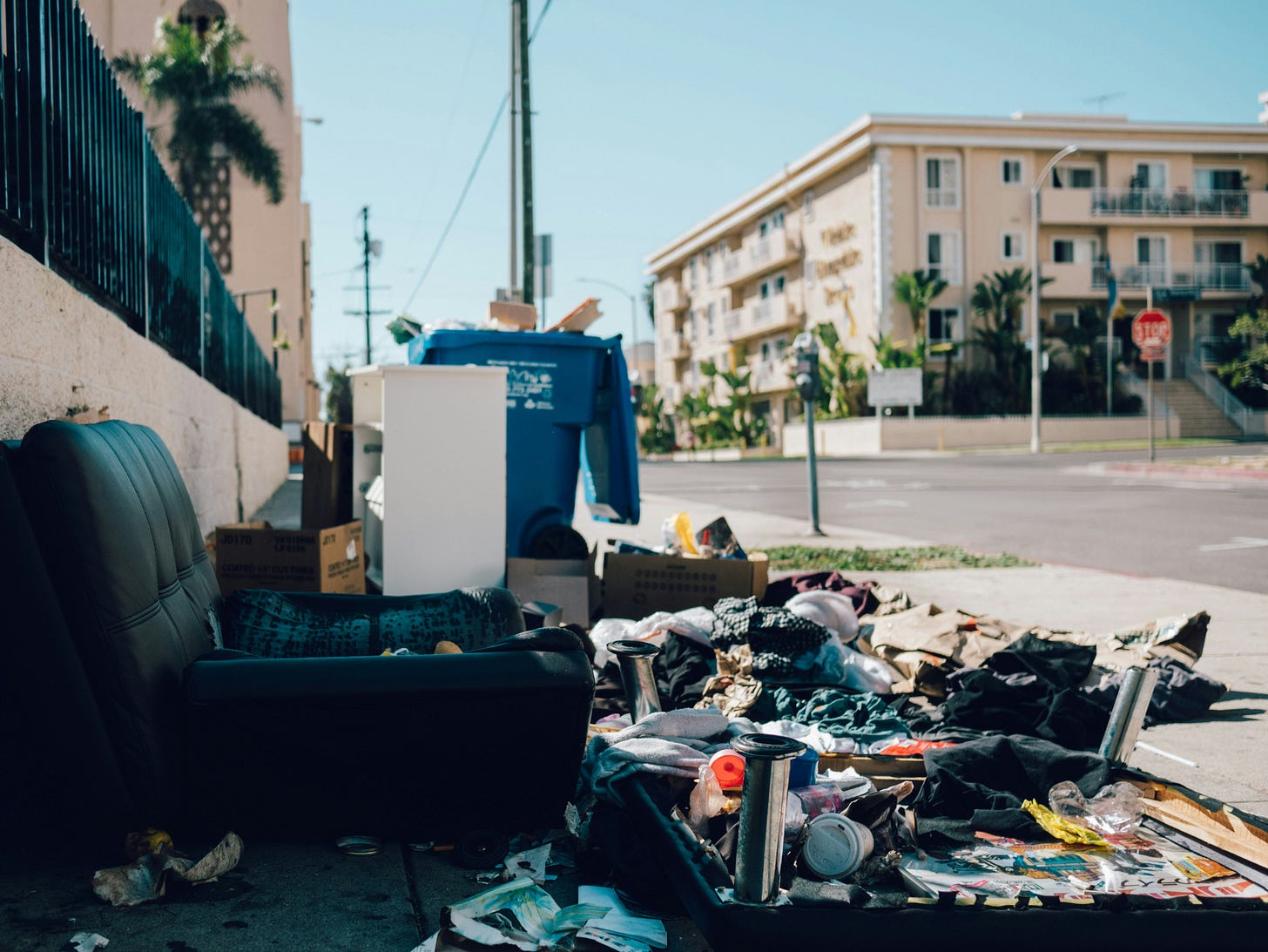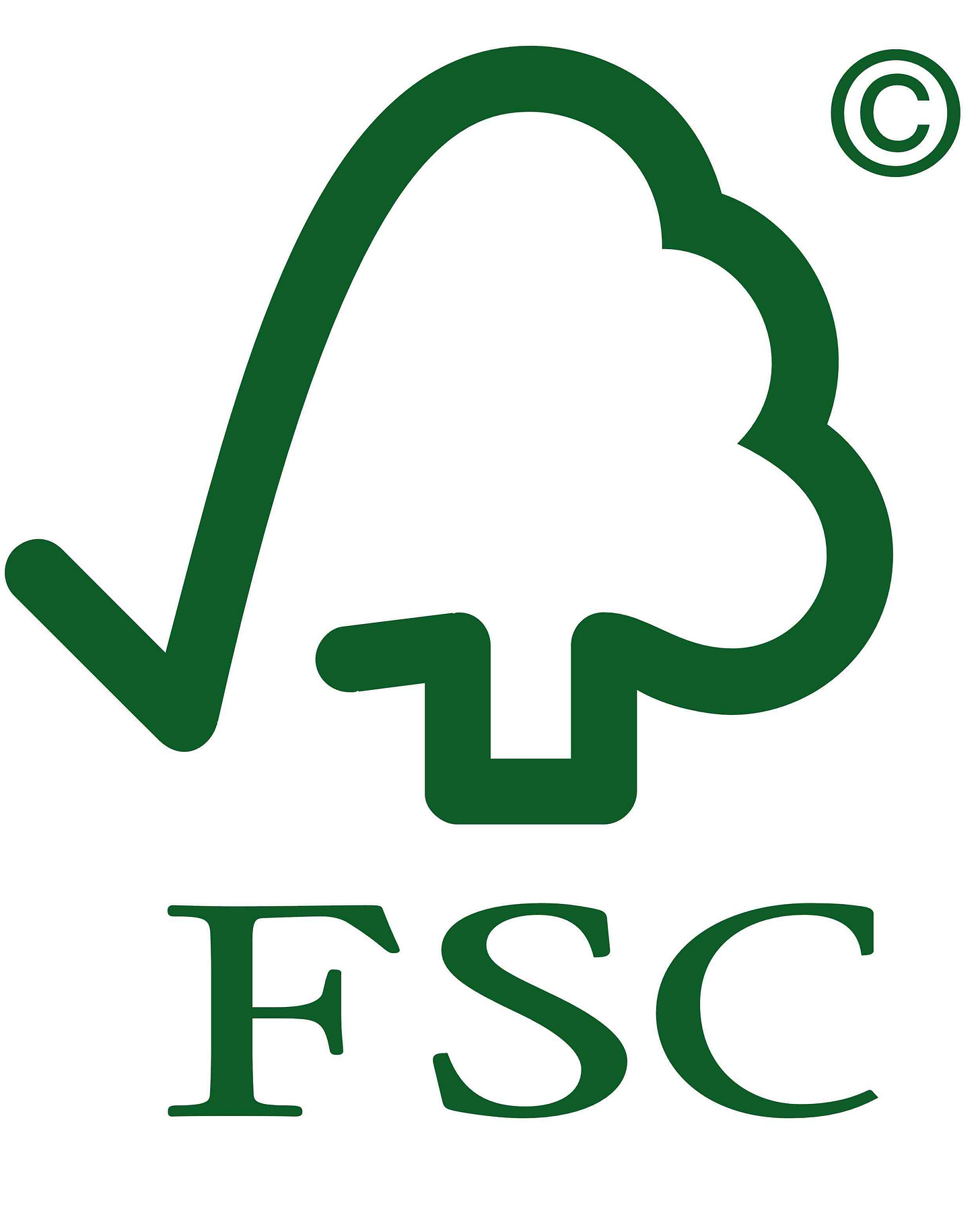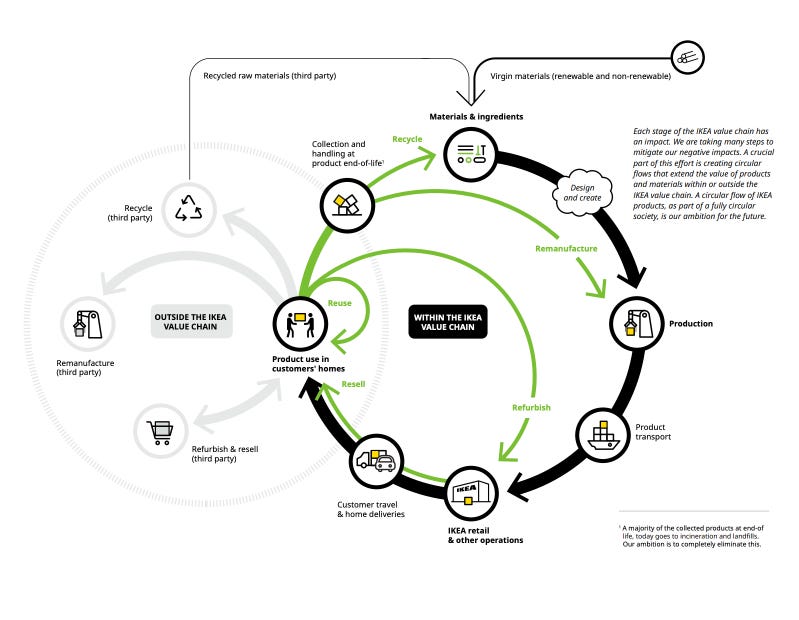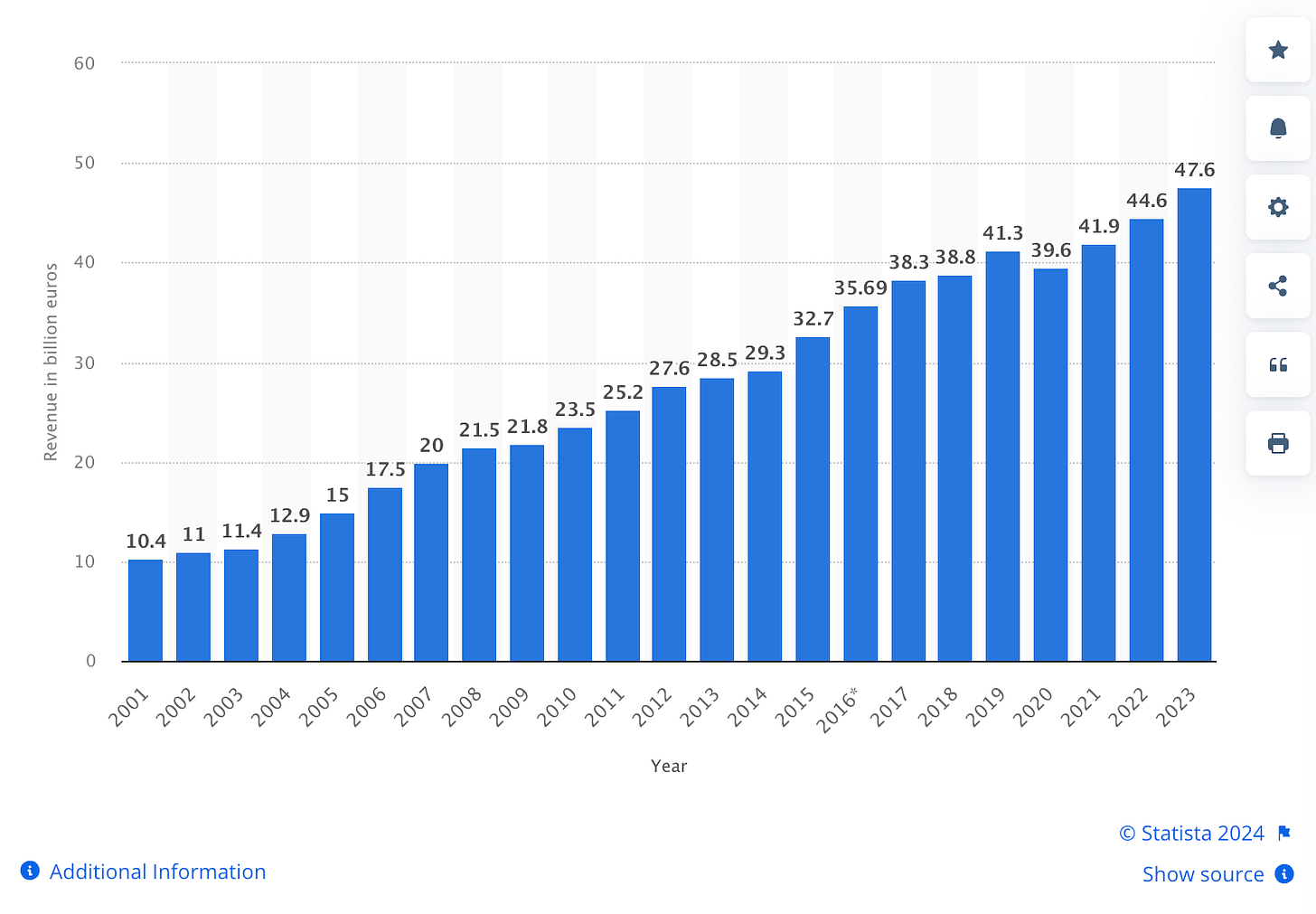The Future of Furniture | You Better Start Recycling
Is IKEA defining the future of the industry all by itself? Is this the leadership we need?
👋 Hi, it’s Michiel, with a warm welcome to Mara, Eduardo, Kristian and 8 new subscribers who joined Sustainable Growth. It’s a pleasure to have you here.
I’m on a mission to discover sustainable succes stories and learn from the professionals and entrepreneurs behind them. Sharing with you what I learn.
Last week’s post on Fashion left me with a bitter taste.
Discovering that industry leaders are not delivering on promises made and seeing a whole industry going the wrong direction.
While researching for this weeks post, I must confess that I lost some of that bad taste. Again, I found that ‘fast, low-cost-junk’ is a major trend. Again, led by the biggest brands in the industry.
However, it is not all bad. Since it seems that the industry leader actually commits to sustainability and circularity. They’re doubling down on it, so they make it seem. With the inherent risk that their messaging outruns their actual progress. We’ll get to that.
Let’s talk furniture.
The size and impact of the ‘Furniture Industry’
Last years global revenue for furniture brands was $660.000.000.000, so 660 billion. A third of the size of the fashion industry. We’re talking all types of furniture here, from bedroom to kitchen, and decorative to outdoors.
Raw material production (wood, steel, and plastics) along with high energy and chemical consumption in manufacturing, contributes to a significant environmental footprint for the furniture industry. The emissions from the furniture industry account for a staggering 12% of global annual emissions, double the impact of the fashion industry.
The industry is expected to grow 5% year over year. Seeking growth mainly from developing regions (Asia/Pacific, Americas and Africa) and online channels. It’s unclear to me what the trajectory of the climate impact is at this point, but it is safe to assume it’s currently growing and might do so for few years to come. Despite the current sustainable efforts.
The sustainable slice of this industry is estimated to be close to 7% of the annual revenue right now. Growing slightly faster than the industry average and expected to reach 10% in 2028.
So where is this industry heading and what opportunities arise?
Fast & Low-Cost-Junk….. again
Yup. Fast Furniture is a household thing (pun intended).
IKEA and Wayfair, among others, have been the main drivers of this trend for decades. Introducing low cost furniture designed to be ‘in fashion’ for a certain time, only to be replaced by new trends and new items. Most of materials used in these items (MDF, cheap plastics and chemicals) make them short-lived and for one-time-use only.
When moving, Gen Y (the millenials, born between 1980-1995) tend to move few furniture with them, compared to earlier generations. Why?
Items are already damaged from use or will easily break when taken apart or transported.
Replacements are cheap and ‘trendy’ or fit into the new design of the new home.
No reason to keep holding on to them. So, where do these items go?
Sadly, it’s very low value and low quality deem them ripe for the landfills straight away. Taking up immense space, breaking down slowly and releasing much of their toxics slowly into the environment.
It’s hard to find accurate data on the amount of overproduction, amount of fast furniture produced and how these volumes are rising, but many countries have raised the alarm in recent years though. The amount of cheap furniture clogging up the landfills is rising rapidly. It’s estimated that we’re producing 450% more furniture ‘waste’ than 50 years ago.
This is worrisome.
As is the rapid adoption of MDF (medium density fibreboard). Woodfibre of different sources are mixed with toxic glue/chemicals to create these all-purpose boards under heat and pressure. Most MDF is made with formaldehyde, a known carcinogen.
Only recently sustainable alternatives have surfaced, but those are not yet available on scale. Fortunately, not all is bad.
Good Wood - adoption of sustainable forestry
Wood: the prime example of a sustainable material, inherently circular by nature.
The wood industry is not so sustainable. To say the least.
Forestry and logging can be done in many unsustainable ways.
So that is what mankind did, at scale. And what we still do. Resulting in rapid deforestation. Some efforts are made towards sustainable forestry, like the Forest Stewardship Council (FSC). A logo we’re all familiar with.
The effectiveness of these sustainable practices is up for debate, but for now I’m treating them as a positive trend. It certainly is a step in the right direction.
Please realize that the demand for timber will keep rising, partly due to the righteous efforts of ‘environmentalism’. Plastics are often replaced by paper or wooden alternatives. Today, the furniture industry accounts for 15% of global timber logged. For long the origin of materials used was a black box.
However, this is slowly changing for the better. With the single biggest user of wood leading the way. About 1% of wood is used by IKEA alone. Let that sink in. 1 in every 100 trees cut is for IKEA. Over 2023 they report that close to 98% of their timber is from FSC-sources.
Optimists would argue that they show the industry how it’s done. Critics might argue they’re just answering to consumer demands. Both are right. Consumers are actively searching for the origin of materials used in their furniture. 80% distrusts the information provided by brands, yet over 66% will pay a premium if they know the materials are from sustainable sources (FSC, recycled, renewed or reused).
I have not found a reliable source that shows the exact percentage and trend of sustainable wood used in furniture production worldwide. Rough estimations are around 25%-30%. European and North-American brands are increasing their reporting on the matter, a major first step in accountability.
If you do know a good source, please let me know. Right now I’m relying on the companies reporting on themselves. Which is not a bad thing, not at all. It does leave much room for greenwashing and interpretation though.
Though I like how thorough IKEA is with their reporting. Especially when compared to most billion-dollar-businesses.
What are the Swedes up to?
IKEA, earning close to 50 billion in annual revenue, is by far the biggest in the industry. The other big brands in the global top 10 are doing between 0,5 and 14 billion each.
IKEA also is the most adamant about it’s ambitions and responsibilities. They want to be 100% circular in 2030, by focusing on three elements:
Renewable
Recycled
Eliminating waste
I’m all for big dreams, companies with daunting visions are attractive. Yet, most hold their cards very close to their chests. IKEA however, is publicly reporting on their progress. What numbers do they share?
22% decrease in global annual footprint since 2016.
75% - 90% use of renewable energy (differs between parts of the business).
47% reduction of use of plastic packaging (replaced by mostly paper)
The European production facilities use 70% renewed/recycled plastic.
It’s hard to factcheck a company of this size, so I’ll have to take their word for it at the moment. And they make that very easy with a well-drafted, good looking report. They obviously care about delivering this message.
Is this clever marketing?
Yes. It is. No doubt about it.
IKEA dominates every search engine on the topic and puts a lot of effort in repeating their ambitions, efforts and progress (offline and online).
IKEA has identified, possibly earlier than it’s competitors, what consumer behavior is going to look like in the next decades. And they’ve positioned their brand right in the center of it.
IKEA = functional, eco-friendly, affordable.
Wait…
This is about me. Being a millenial myself, this is my top 3 criteria for most things I buy. Certainly the purchases with a certain cost, like a couch, or a table.
Though I’d like to think I am very special…. more than 60% of my generation values this exact combination the way I do.
Truth be told. If IKEA wasn’t going this direction I would indeed have avoided them by now. So it is effective marketing, for one.
And it will earn them top dollar. Gen Y has money to spend and is buying their first homes worldwide. This is the time to ‘hook’ us.
It could be much more than just good marketing.
What if they manage to turn this ship around?
IKEA, being the industry leader in 2016 with close to zero sustainability points (making those up along the way now) and achieving 100% circularity by 2030. That would be remarkable. As it aids the planet, but it will certainly aid IKEA.
Meanwhile they’re not only appealing to consumers, this strategy aids them tremendously in retaining and hiring top talent. Which is a big competitive advantage by itself.
What if they manage to get their whole supply chain (including thousands of suppliers) circular. 100% renewable, free of toxics and free of waste. That would be next level impressive. That would be the type of leadership that is needed to save this planet. And it would make IKEA one of the most sexy brands out there.
Yes, you read it here first.
Sustainability is sexy.
How about profits?
Broadly, the net profit margin for furniture makers is between 4% and 10%. Some retailers that dominate a channel or niche might see higher margins, but those usually have no manufacturing and limited scale.
Since ‘Green’ consumers are prone to pay a premium for sustainable solutions there might be a chance to increase the margins in the future.
On the short term I expect the investments in renewable energy, new materials, new ways of manufacturing, new packaging and transportation to have significant impact on profit as a whole. It’s a very costly transformation.
IKEA for instance has seen an impressive revenue growth (20% per year in the last 2 decades), but their profits are taking hits compared to their pre-sustainable-strategy era, which ended in 2016. Obviously there is more to take into account here, like COVID and the rise of online shopping, but IKEA had a net profit margin above 10% for a long time.
Since they’ve announced to work towards ‘100% circularity in 2030’ their profits dropped significantly, and they’re reporting to have spend billions already fueling this transition.
This long term play has many upsides though:
IKEA will have the biggest sustainable supply chain in the industry, locking their partners in by helping them transition, possibly locking competitors out.
IKEA can become the ‘hub’ for many resources. Becoming a major producer of recycled-material itself, therefor controlling much of that supply-chain.
IKEA has the potential to become very cost-effective, by having direct access to supplies (possibly at a discount compared to market prices) and low-cost energy (renewables are cheap!).
Today, IKEA has a marketshare of about 7%. I believe they are able of doubling that in the next decade. And during this transition, they’ll find numerous ways to improve their profit margins.
Outpacing the market - investment perspective
The expected Compound Annual Growth Rate (CAGR) of general furniture brands is 5,5% towards 2030. Sustainable brands are expected to see higher growth of your investements with 9,5%.
An €100 investment today would yield €145 (industry average) or €188 (sustainable brands) in 2030 with these CAGR’s. The industry as whole might therefor not be the most interesting to invest in. Yet, picking the ‘winners’ might have vastly superior yields.
For example, if IKEA keeps up with the double digit revenue growth year over year and manages to increase its profit margins while completing this transition. We’re talking CAGR’s in the range between 15% and 30%.
That same €100 investment might have grown to a value between €266 and €627.
Don’t take this as advice. These are my quick assumptions. Off the bat.
Feel free to correct me on these. I certainly will return to these in future posts to correct them where I can.
Conclusion
Looking at the three pillars of sustainability: planet, people and profit. We’ve discovered there is an appealing business case in becoming sustainable. Certainly when it comes to planet and profit (not sure how they fare on the people front). IKEA seems to be showcasing this. It’s leading the way in communication about their efforts. There is the risk that they end up not achieving their goals. I guess we’ll know the real outcome sooner or later. For now I’m giving them the benefit of the doubt. Let’s hope they make it work.
I would love to talk to the professionals trying to bring this vision into practice in their daily work within IKEA. Discover what works for them. How such a bold strategy impacts their work. If that is something you want to read I might put in some effort to make that work. Would you like that?
On the broader industry: I’ve only barely scratched the surface. It seems there are some hopeful trends and inspiring strategies at play. At the same time, it’s still a big black box. Which is a shame for an industry accounting for such high emissions and waste production.
At this point I think the negative impact and trends of this industry still vastly outweigh the positive trends.
Consumer perspective
Repurpose, refurbish, reuse, recycle.
That is hard to do, I know. And it takes quite some time and effort.
But when it comes to furniture the impact is massive.
I’m convinced that ‘guilt tripping’ is not going to work when it comes to fashion, food, travel and joyful experiences. We’re talking (daily) habits and activities people are living for. Changing the supply side is easier and faster than changing human behavior. Meet those demands with sustainable offers. That’s where we should spend our time.
Furniture might be an exception. We spend around €700 per person (EU, USA) on few items. Probably also on few occasions per year. I think you can effectively guilt trip yourself out of buying the wrong furniture. Clearly, we already are. Consumers already actively demand to know the origin of materials and how it’s produced. Which is great.
We do have to step up our game on the waste issue. We, consumers, are the ones mindlessly throwing stuff away instead of keeping it in the system.
I’m going to hold myself accountable for every piece of furniture leaving the house this year.
Will you do the same?












